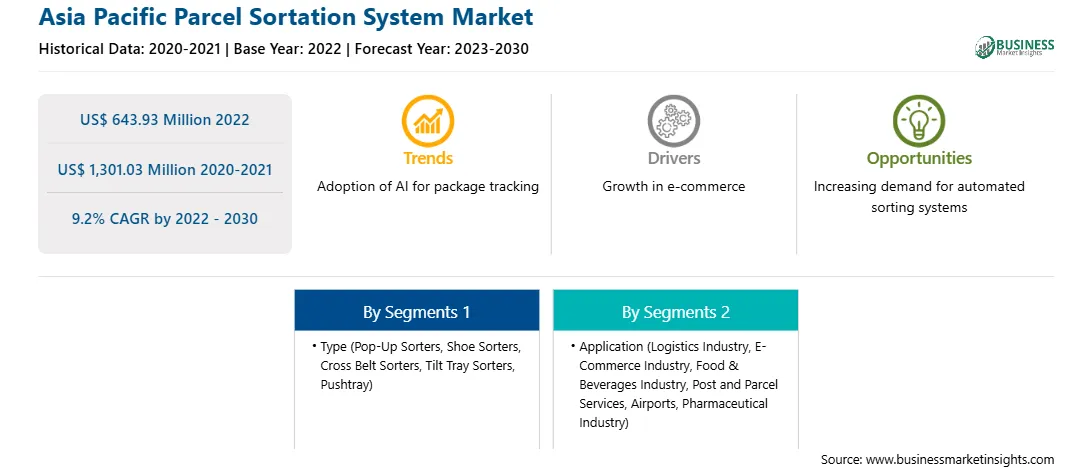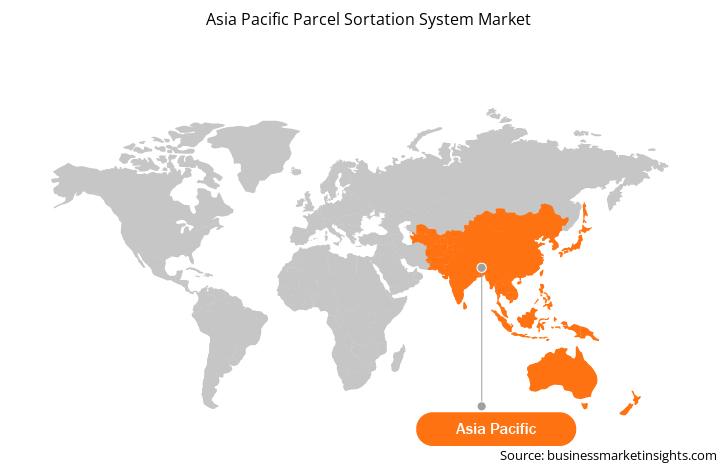A warehouse management system (WMS) refers to the monitoring, control, and optimization of warehouse-related activities and associated distribution systems. As the volume of parcels continues to grow, the need for scalable and flexible sortation solutions is also increasing significantly. A WMS can adapt to changing requirements, handle various parcel sizes and shapes, and integrate with different types of sortation equipment, making it an attractive option for companies looking to expand their parcel sorting capabilities.
In addition, with the rise in e-commerce portals, the retail industry has shifted its marketing from brick-and-mortar stores to online e-commerce websites to reduce infrastructural costs. The adoption of warehouse management systems accelerated due to the increase in E-commerce industry. The different type of warehouse management systems such as parcel handling and sortation systems is gaining prominence across different regions, attributing to the significant rise in the volume of items in the warehouses. As a result, the number of warehouses that are integrating their parcel sorting units with advanced sorting systems is expected to increase, which is likely to create a lucrative opportunity for the players operating in the parcel sortation systems market in the coming years.
Asia Pacific is predicted to record the fastest-expanding market for parcel sortation systems during the forecast period. Huge population growth and a rise in disposable incomes are a few factors increasing parcel volumes in the region; hence, to manage such increased volume, logistics players are using advanced technologies such as parcel sortation systems. Also, rapidly developing e-commerce marketplaces are generating the need for efficient parcel sortation systems in the region. Further, the rising number of sorting centers in highly populated cities in China and India drives the Asia Pacific parcel sortation system market in Asia Pacific.
The Asia Pacific parcel sortation system market is segmented type, application, and country.
Based on type, the Asia Pacific parcel sortation system market is segmented into pop-up sorters, shoe sorters, cross belt sorters, tilt tray sorters, pushtray, and others. The cross belt sorters segment held the largest market share in 2022.
Based on application, the Asia Pacific parcel sortation system market is segmented into logistics industry, e-commerce industry, food & beverages industry, post and parcel services, airports, pharmaceutical industry, and others. The others segment held the largest market share in 2022.
Based on country, the Asia Pacific parcel sortation system market is segmented into Australia, China, India, Japan, South Korea, and the Rest of Asia Pacific. China dominated the Asia Pacific parcel sortation system market share in 2022.
Bastian Solutions LLC, BEUMER Group GmbH & Co KG, Daifuku Co Ltd, Honeywell International Inc, Interroll Holding GmbH, Murata Machinery Ltd, Siemens Logistics GmbH, and Vanderlande Industries BV are some of the leading companies operating in the Asia Pacific parcel sortation system market.
Strategic insights for the Asia Pacific Parcel Sortation System provides data-driven analysis of the industry landscape, including current trends, key players, and regional nuances. These insights offer actionable recommendations, enabling readers to differentiate themselves from competitors by identifying untapped segments or developing unique value propositions. Leveraging data analytics, these insights help industry players anticipate the market shifts, whether investors, manufacturers, or other stakeholders. A future-oriented perspective is essential, helping stakeholders anticipate market shifts and position themselves for long-term success in this dynamic region. Ultimately, effective strategic insights empower readers to make informed decisions that drive profitability and achieve their business objectives within the market.

| Report Attribute | Details |
|---|---|
| Market size in 2022 | US$ 643.93 Million |
| Market Size by 2030 | US$ 1,301.03 Million |
| Global CAGR (2022 - 2030) | 9.2% |
| Historical Data | 2020-2021 |
| Forecast period | 2023-2030 |
| Segments Covered |
By Type
|
| Regions and Countries Covered | Asia-Pacific
|
| Market leaders and key company profiles |
The geographic scope of the Asia Pacific Parcel Sortation System refers to the specific areas in which a business operates and competes. Understanding local distinctions, such as diverse consumer preferences (e.g., demand for specific plug types or battery backup durations), varying economic conditions, and regulatory environments, is crucial for tailoring strategies to specific markets. Businesses can expand their reach by identifying underserved areas or adapting their offerings to meet local demands. A clear market focus allows for more effective resource allocation, targeted marketing campaigns, and better positioning against local competitors, ultimately driving growth in those targeted areas.

The Asia Pacific Parcel Sortation System Market is valued at US$ 643.93 Million in 2022, it is projected to reach US$ 1,301.03 Million by 2030.
As per our report Asia Pacific Parcel Sortation System Market, the market size is valued at US$ 643.93 Million in 2022, projecting it to reach US$ 1,301.03 Million by 2030. This translates to a CAGR of approximately 9.2% during the forecast period.
The Asia Pacific Parcel Sortation System Market report typically cover these key segments-
The historic period, base year, and forecast period can vary slightly depending on the specific market research report. However, for the Asia Pacific Parcel Sortation System Market report:
The Asia Pacific Parcel Sortation System Market is populated by several key players, each contributing to its growth and innovation. Some of the major players include:
The Asia Pacific Parcel Sortation System Market report is valuable for diverse stakeholders, including:
Essentially, anyone involved in or considering involvement in the Asia Pacific Parcel Sortation System Market value chain can benefit from the information contained in a comprehensive market report.